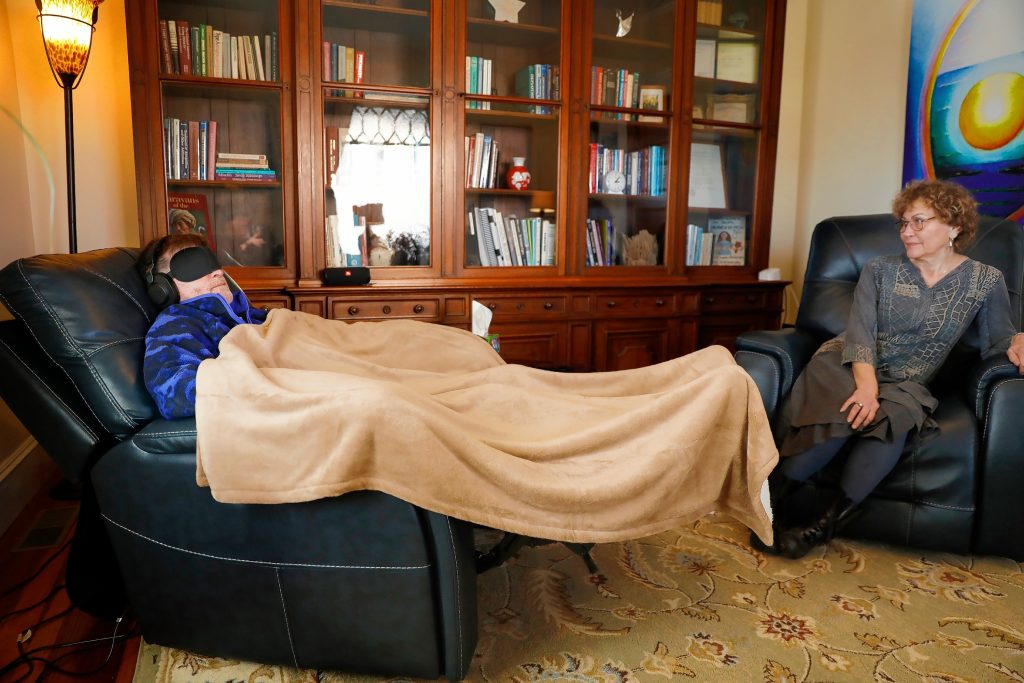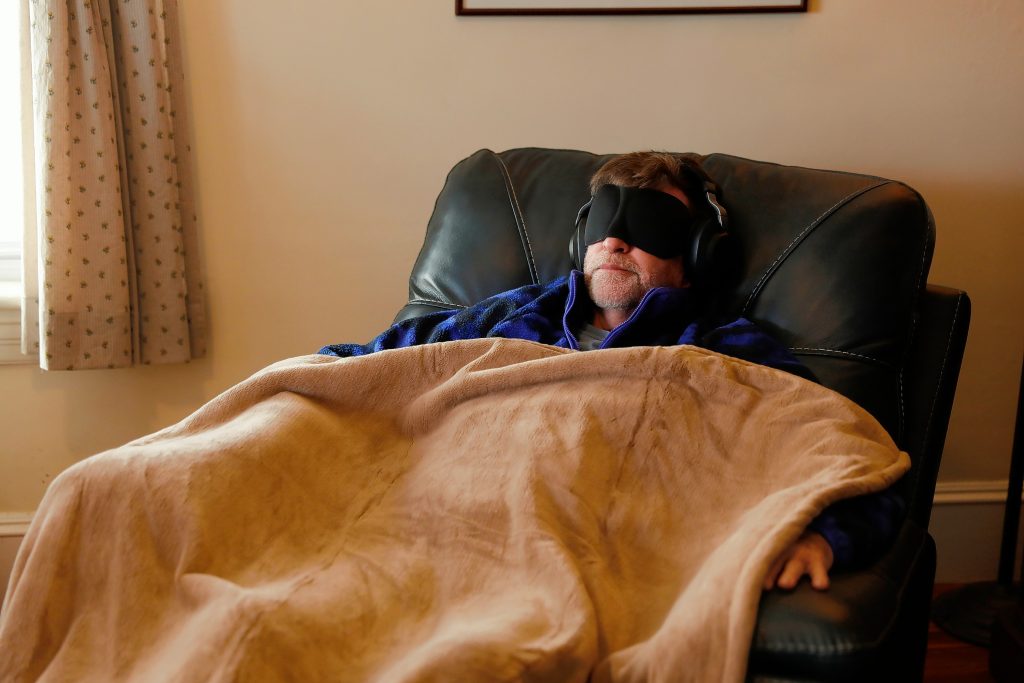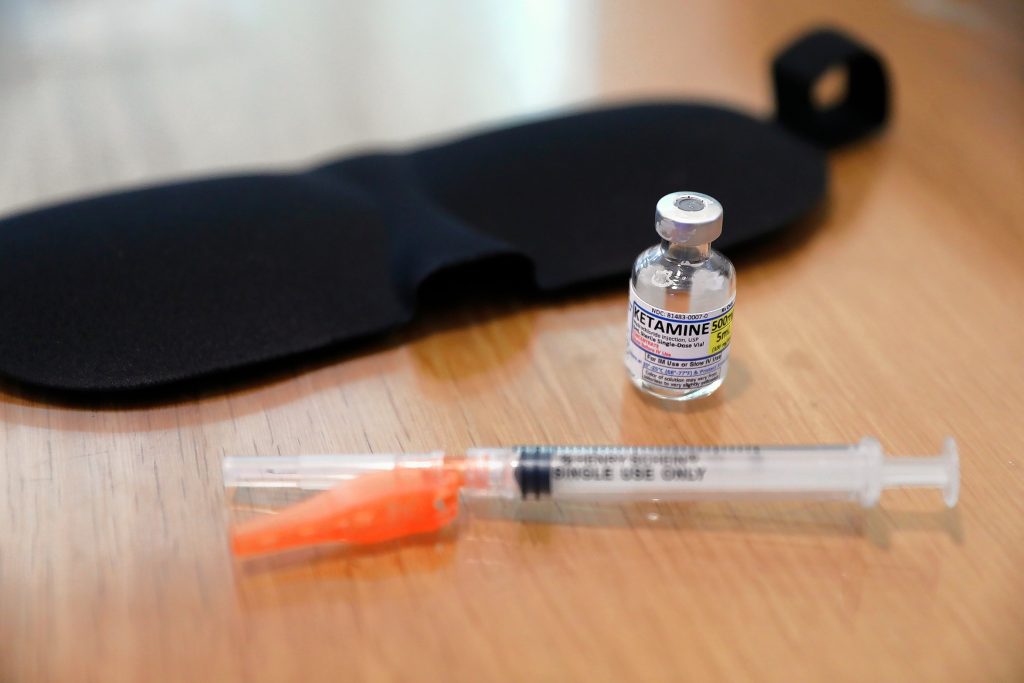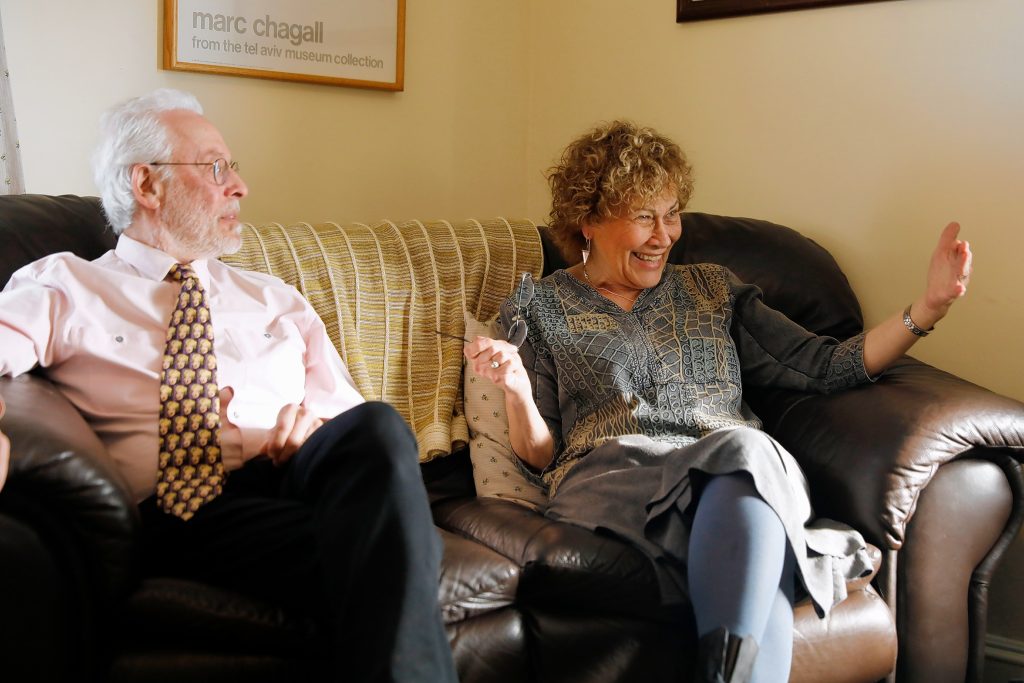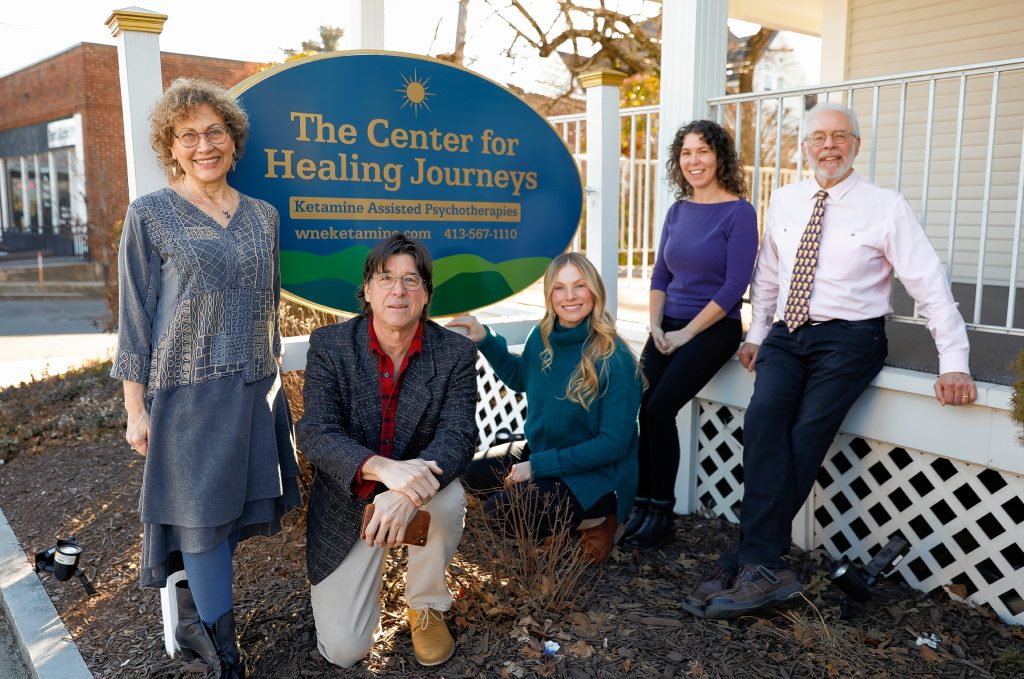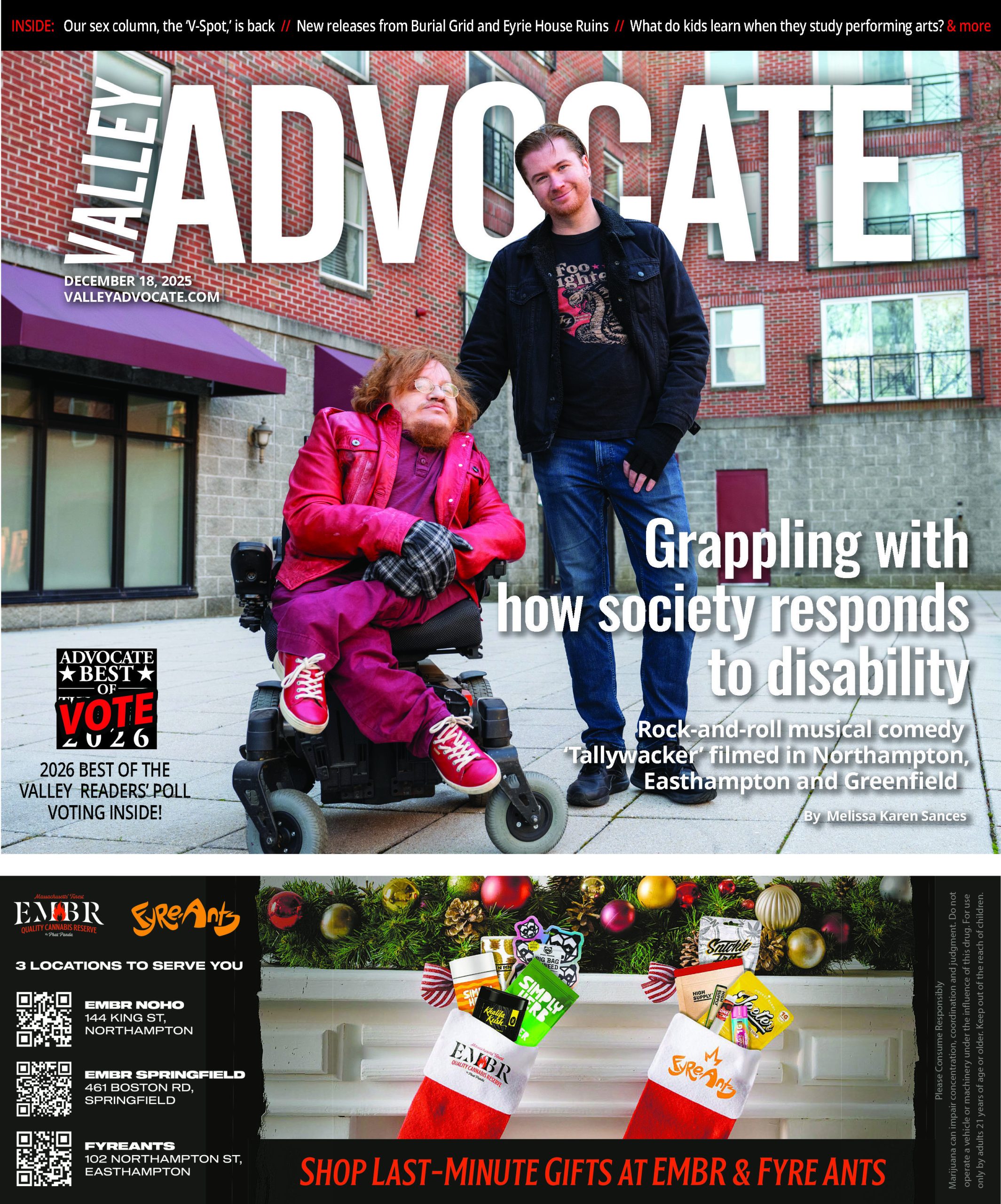For the Valley Advocate
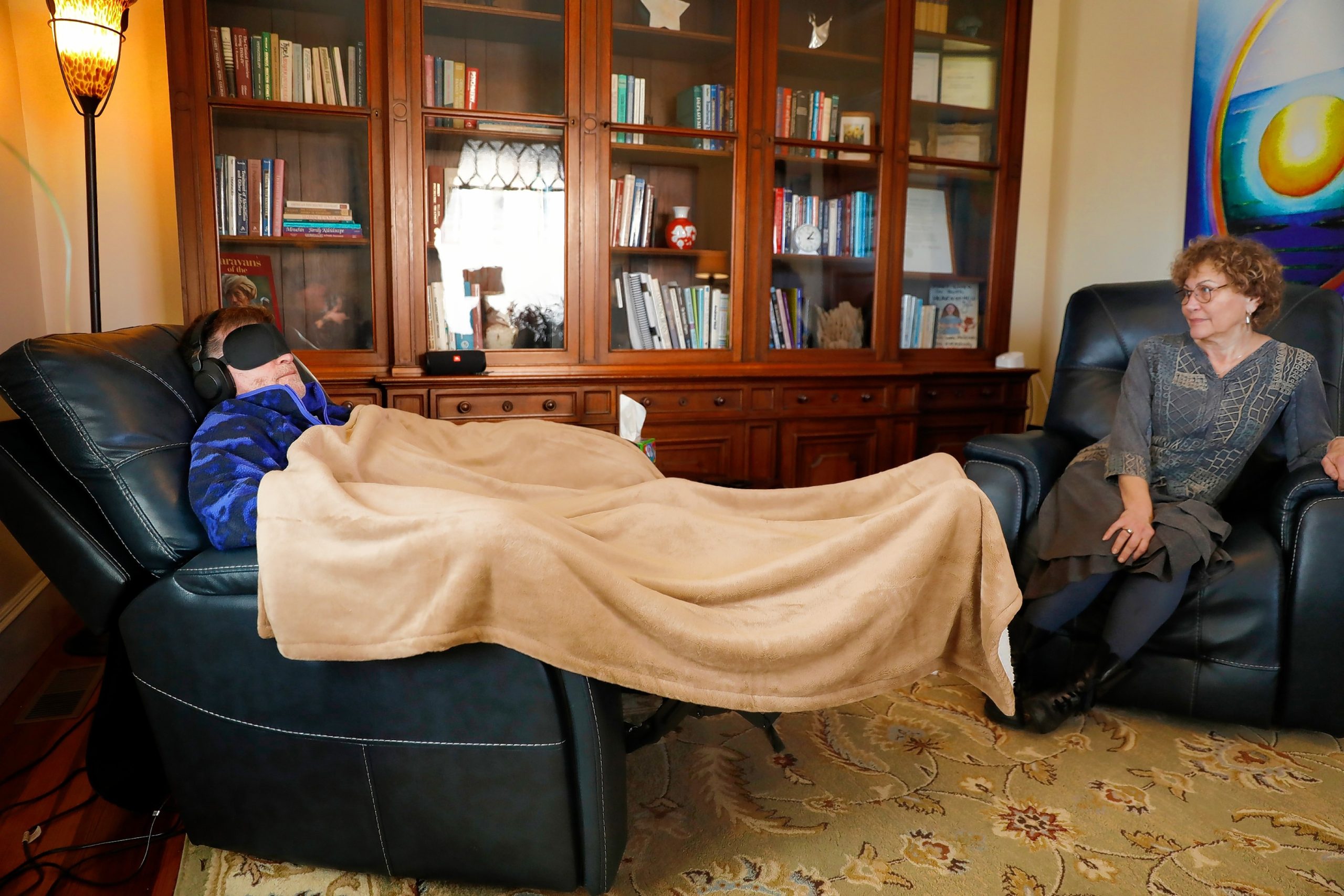
STAFF PHOTO/DAN LITTLE
Clinical Supervisor Lilly Gaev, LCSW, right, sits with Bob Flaherty as they demonstrate the experience of ketamine assisted psychotherapy at the Center for Healing Journeys in Northampton.
A gamechanger, they call it. A chance to face the challenges of your life head on. To free your mind, unencumbered by old negative patterns. Empowering your life. Re-setting your brain.
Though it’s been around for decades, ketamine, still employed as an anesthetic, has, in recent years, been introduced in a dramatically different way: a psychedelic drug in a psychotherapeutic setting.
“Powerful medicine,” said Lilly Gaev, LSCW, co-founder of The Center for Healing Journeys in Northampton, which specializes in ketamine assisted psychotherapy. “One of the most effective additions to our toolbox in decades.”
It’s been shown to give fast relief from anxiety, addictions, suicidal ideation, PTSD, fear of dying and many other things, including maybe the toughest bear in the cave, treatment-resistant depression. It’s said to have a rapid and robust antidepressant effect.
Mostly it deals with behaviors that find a person stuck in a rut.
But the psychedelic part can be a tricky pill to swallow for our collective post-War on Drugs mind. I mean, the skillet with the frying eggs and our brains on drugs is still back there in the recesses with the rest of our TV-addled memories.
There is often concern on the faces of people who come through the Center’s doors. “Some people are risk takers,” said Gaev, “some are cautious about losing control. And the psychonauts — people who use all kinds of mind improving things. You have people excited, other people freaking, but good candidates when they feel safe.”
“The disassociation of your uptight self is a tough first step,” said Gaev. “People are so hard on themselves, so disappointed, to the point of ending their lives. This can help.”
Ketamine has been evolving as treatment for depression for years, but the last five have seen a tremendous interest in the drug. “We said hey, the time has come, let’s open up some eyes and ears.”
So the question arises — would you do it? Would you be willing to take a psychedelic trip in an attempt to better your life?
On the Center’s website: “We provide a safe and comfortable setting to experience the non-ordinary state of the ketamine trance and make sense of the psychological material that arises under its influence.”
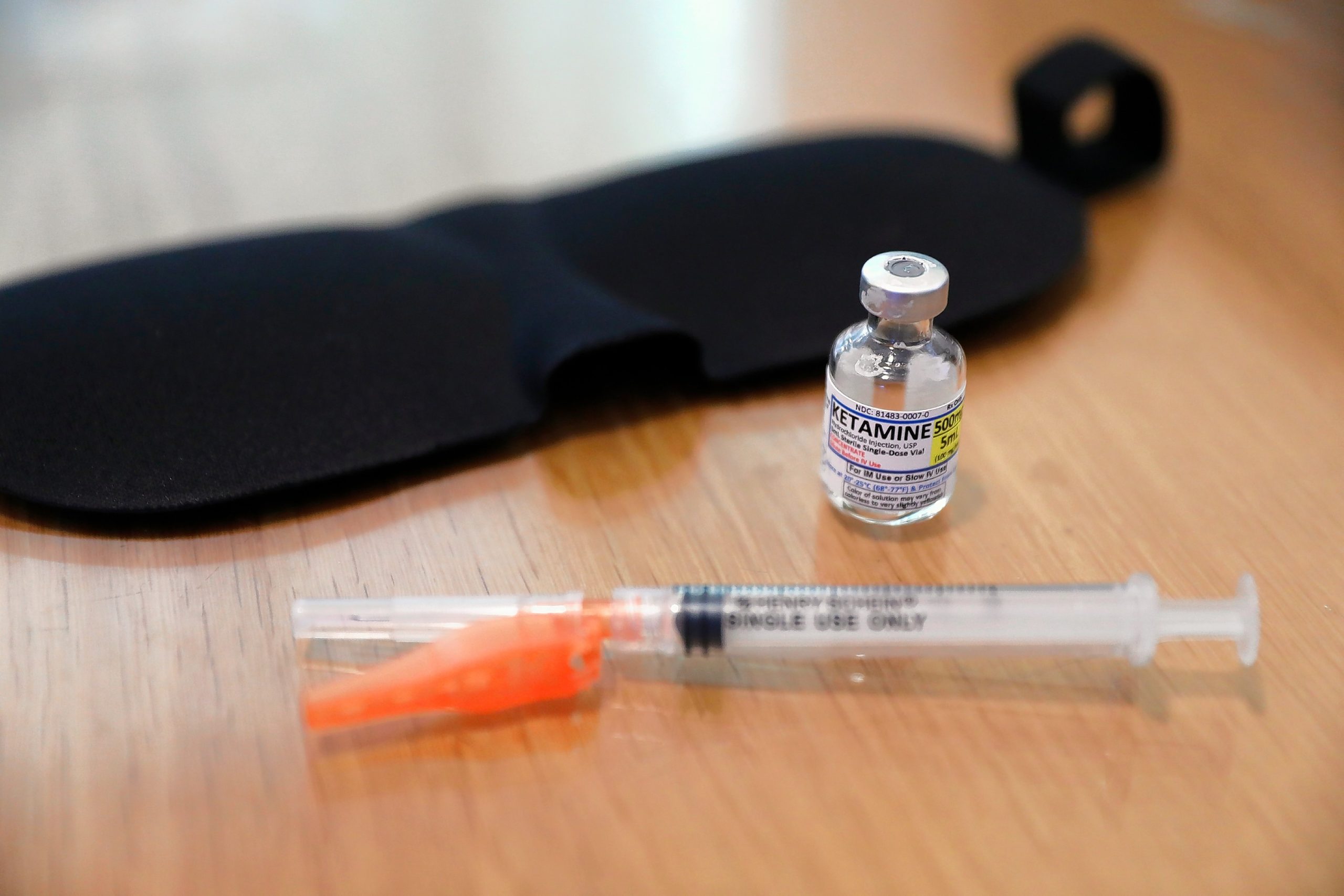
A vile of ketamine and syringe along with an eye mask at the Center for Healing Journeys in Northampton.
STAFF PHOTO/DAN LITTLE
Uh, trance? As in: You-are-getting-sleepy? Oh boy.
The running dead
Hallucinogens? Psychedelics? Hmmm… It’s sorta like eating beets for the first time — if they don’t make your whole body shudder at first taste like they did mine, then you happily go on to serve them every night at dinner, while I can’t bear to have them within smelling distance. So it was with acid, as we called it. Weed? I could keep up with Snoop Dogg, conversationally at least, and I had my brief fling with cocaine. But neither of those involved, shall we say, imagery.
I met her in Central Square. All in black she was, cape, hood, laced-up boots, both of us looking through some display window at night, talking to our reflections. She invited me to the “party to end all parties” on Beacon Hill. We took the Red Line to Park Street and hiked cobblestones to her apartment and she asked if I had ever dropped acid and I hideously lied “sure” and she gave me something to put on my tongue and I felt it dissolving. There were tons of people in the house. She showed me her bedroom. She’d told me on the subway that she slept in a coffin and I laughed out loud but there it was alright, pillow, silk sheets and everything. Note to self: If she starts to give you a hickey, jump out the window.
Then the dinging of a little bell in the living room, and she grabbed my arm and took me there, as we converged with dozens of others and sat down cross-legged on the rug, all facing the fireplace — the only light in the room — and you could feel some sort of giddy anticipation among the others, as an edgy tingling kicked up inside you. Then a collective gasp, as a stentorian voice from the back of the room, a voice deep enough to scrape bottom and make your bone marrow chill, ominously intoned: “The Ancient Egyptian Book of the Dead … Chapter One.”
Slowly, painstakingly, the Underworld’s chief mouthpiece took us deeper and deeper into the murk. “Book of the Dead” murk, floating through underground rivers in a semi-mummified state, hostile forces nipping at every turn, torment relentless. When John Lennon wrote “I know what it’s like to be dead,” he had likely just come from one of these get-togethers. And it’s one thing to be dead, a thing we all fear to some extent I guess, but to die and have all your problems just get worse is horribly unfair.
But you don’t have time to dwell when you feel Orson Welles’ Macbethian breath on your neck as he poles you deeper and deeper into the rivers of hell.
He has me convinced that I am dead, or something close to it, with me and my rotting shrouds fighting off demons that are right there with no way out — there are fanged creatures guarding the gates! It might have been The Weighing of the Heart that got me, and the drooling ravenous beast standing by to devour it. By the time my screaming corpse was assailed by human-headed birds and giant goddamn snakes I only knew one thing — run for your life! And madly I fled, up and out the room, past the coffin, tumbled down three flights of stairs and ran, or something like it, to the ironic “safety” of the Boston Common and the MBTA, where horned and sharp-toothed visions flickered in the train’s windows as it barreled through the tunnels for Paradise.
And that, as it is with beets, remains my only experience with psychedelics. Until last week.
Neurons firing
The Center for Healing Journeys sits quietly inside an old Victorian house on King Street that once served as the location of a funeral home. I know what you’re thinking — now cut it out.
I was met at the door by the warm and friendly Lilly Gaev and the Center’s other co-founders, Lilly’s husband of 52 years, Bennett Gaev, MD and Peter Corbett, LICSW. All three have practiced in the Valley for decades.
We repaired to Corbett’s office, with evocative artwork on the walls and a recliner that hugs. They are a likeable bunch, all seniors in great shape, all dedicated to the contraption near to my heart, the bicycle. In fact, they may be on another level entirely. Corbett once pedaled his unicycle 500 miles from Burlington, Vermont, to the White House to raise donations for Bernie Sanders’ 2016 presidential run, and the Gaevs have a tandem bicycle they’ve taken all over the world and pedal every year in the Pan-Mass Challenge. Lilly Gaev wishes she had a stable of tandems to loan to her clients in couples therapy. “They’d either saw it in half or learn to love it,” she laughed.
But ketamine is the topic of the hour. The drug is essentially a glutamate modulator, which activates other systems like dopamine, inducing a broad array of new neuronal connections. And I say that with conviction.
“It’s been coming, psychotherapy with psychedelics and (ketamine) is the one that’s legal,” said Bennett Gaev.
“It’s most effective with people who have treatment-resistant depression,” said Corbett, “people who are kind of desperate. They’ve tried everything out there and nothing has worked.”
Though the Center opened right before the pandemic, impacting foot traffic, Lilly Gaev said that the state of people sidelined at home helped to boost interest. “Everybody was reading about everything,” she said.
Most ketamine providers do not offer psychotherapy as part of the treatment.
The discipline of wedding the two was developed by Dr. Philip Wolfson, director of the Center for Transformational Psychiatry in San Anselmo, California, and author of “The Ketamine Papers.”
“We got our initial training with him,” said Lilly Gaev. “I was worrying about my daughter having her second child. I needed to get centered. Our training included ketamine sessions. I was swimming in the ocean with a sea turtle, real as real could be. It moved me so incredibly. Here I am, anxious about my 45-year-old kid — and here’s this big model of a creature just moving on with life, laying eggs in the sand.”
“It doesn’t work on everybody,” Corbett cautioned. “Where it doesn’t work is with those who are passive, waiting for the medicine to fix them.”
“People will do better with this if there’s appropriate preparation,” said Corbett. “We walk them through it so they know what to expect. They’ll know what it means when they’re starting to feel alterations in their perception.”
The psychotherapy part comes in before and right after the procedure. “You need a thorough psychiatric evaluation,” said Lilly Gaev, “to rule out and rule in accurate diagnoses. People are using this without accurate diagnoses and they’re given samples by their doctor that the drug rep dropped off — try this.”
Though ketamine itself is fast entering mainstream atmosphere, there is slight opposition, due to its stigmatized history as both street drug (Special K, Cat Valium) and horse tranquilizer.
“People who are opposed to it right now always say ‘wait and see, we need more data,’” said Corbett. “The Yale Medical School, NYU and Johns Hopkins have done studies on ketamine. It’s more and more becoming accepted.”
“It’s very much a pharmacologic complement to meditation and Buddhist philosophy,” said Lilly Gaev. “We encourage people to set their intention, find a way out of stuck suffering.”
Okay, but the trip itself?
“You become more immersed in direct experience. Your neurons start to fire and you go along for the ride,” said Lilly Gaev.
“One might have moments of anxiety,” said Bennett Gaev, “but it’s mostly transient. A therapist or guide is with you the whole time. A light touch on the shoulder can help you get through that period of anxiety. That it’ll be over in an hour helps a lot,” he smiled.
A point is also made about the importance of arranging someone to drive you home.
“There have been a lot of psychiatric advances but nothing very radical compared to psychedelic medicine,” said Corbett. “This is the beginning. Within a few years psylocibin (mushrooms) and MDMA (Ecstasy) will also be administered.”
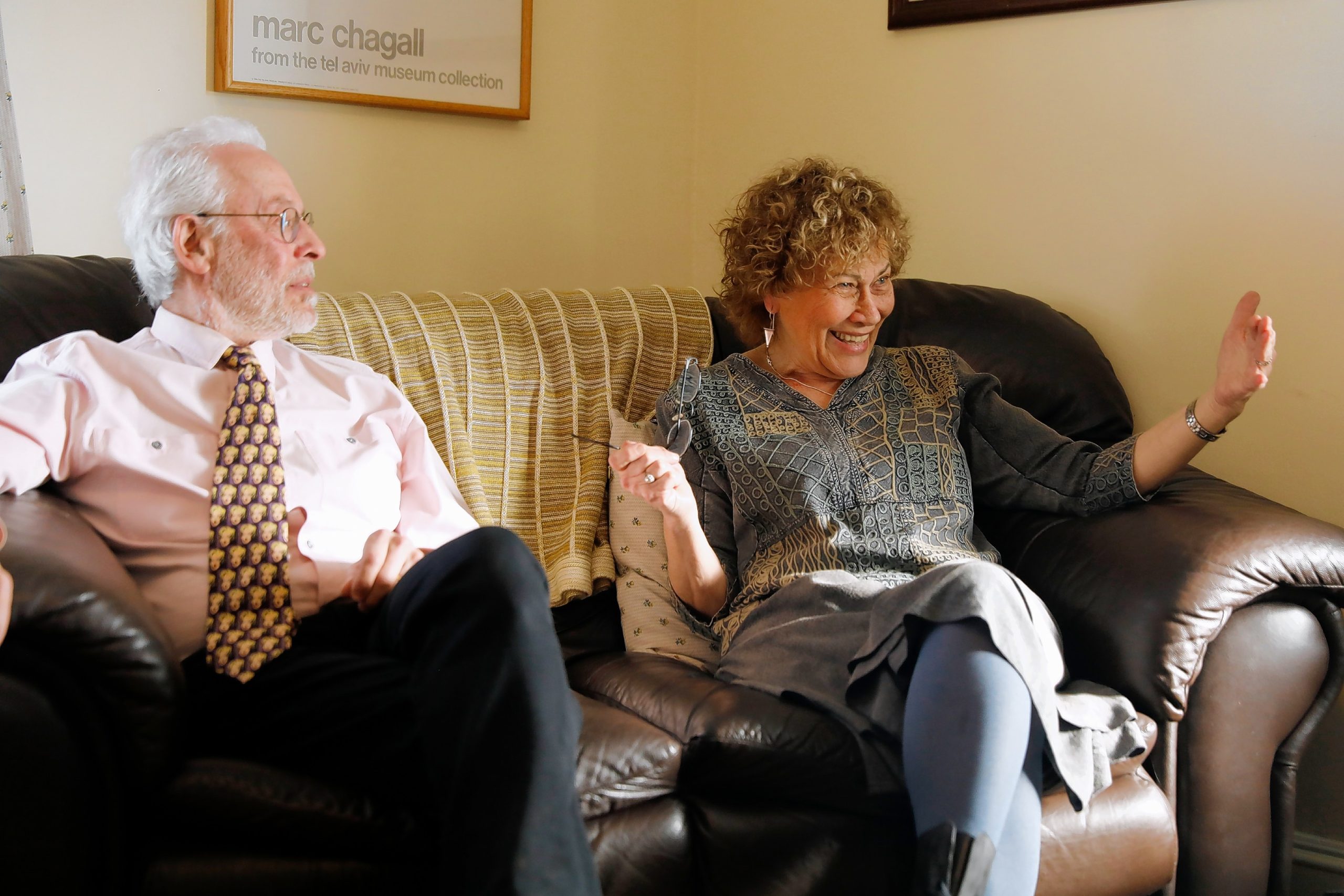
STAFF PHOTO/DAN LITTLE
Medical Director Bennett Gaev, MD, and Clinical Supervisor Lilly Gaev, LCSW, on Tuesday afternoon at the Center for Healing Journeys in Northampton.
Easthampton, Northampton, Cambridge and Somerville have passed resolutions deprioritizing plant-based drugs, while State Rep. Lindsay Sabadosa of the 1st Hampshire District has co-sponsored bills that would make it lawful for adults 18 and over to possess psilocybin, mescaline and many others. In Wyoming, you get 20 years in the state pen.
Although Bennett Gaev refers to ketamine as the newest part of his “pharmacological armamentarium,” he won’t push it on patients. “Some people are better suited to a different therapeutic approach, more traditional. If I can disabuse them of the notion that ketamine will be the panacea, I feel I’ve provided them with a valuable service.”
It’s also rather expensive, making it not as accessible as therapists would prefer. “It’s a challenge because insurance doesn’t pay for it,” said Lilly Gaev.
But it’s also not something that drags on and on, apparently, where you’re coming every Tuesday and Friday for life.
“You do six to eight sessions to get it going, over a few weeks, then you start to space them out,” said Corbett. “Opening neurological pathways — it doesn’t happen right away. But soon, you’ll be less rigid in your perceptions, open to love and connections in your life.”
“You sometimes just need a tune-up,” said Lilly Gaev. Some patients come as little as three times a year.
Anyway, depending on insurance, people can get reimbursed for the psychotherapy component.
Comforts of home
You can also just go for the ketamine without the psychiatry, of course, not to mention prescriptions for the generic Stravato, which is employed via nasal spray in little microdoses. This method, much cheaper, can sometimes lead to abuse and dependence, though such cases are rare, Matthew Perry notwithstanding.
“We don’t typically send it home with clients,” said Corbett. “You want it to be in the context of a real psychotherapeutic relationship. Sending home people with lozenges — it’s done, but we don’t think it’s responsibly done.”
And, like everything else, there’s the black market.
“There’s always going to be someone selling a little packet of something on the street,” said Lilly, singing “Here it is, come and get it!”
Rob Noble of Easthampton attests to the drug’s power over depression but he buys it in crystal form, chops it up fine and snorts it. “At first your mind and body will want to fight it but once you learn how to control it internally it’s the most magical thing,” he said. “You relax and let your eyes go limp. Your body feels like it can stretch across the room. Time stands still. Very eerie but comfortable. The more you relax the more the new world arrives. I can re-dose, lie down and go right back into it. Real disassociation. It changed my life.”
It’s not going to work
The neuro-rigidified disorders that ketamine assisted psychotherapy has been shown to soften, are often borne of childhood or personal trauma. But what of the individual who feels helpless about the warring, starving, glacier-melting state of the world?
“I had episodes of severe depression, terrible self-talk. I was going down a tunnel,” said Lois Hunt, a real estate appraiser from Florence who suffers from treatment-resistant depression.
“My anti-depressants weren’t working at all,” she said. “But I’m a good researcher. I came across it on the Internet — ketamine with psychotherapy. I went looking for something nearby and found the Center, the therapeutic model. My only apprehension: it’s not going to work.”
Hunt began, with Lilly Gaev at her side, with a low dose, choosing lozenges, and then increased to a pretty high dose over the next month or so. “The sensations come on quickly,” she said. “It’s very different, going inward, not thinking. I asked Lilly, ‘Is this a spiritual experience?’ She just shrugged.”
Hunt describes the first treatments as pleasant and peaceful, but love poked through the clouds by the third installment. “One day in my apartment I realized I’m not depressed. I’m like, okay. That constant negative voice was gone. It works on the elasticity of the brain, rewiring patterns.”
As for the Dali-like scenery: “You’re out in nature and things are melting, a sense of movement, a sense of flying. A big vast room with beings, not aliens or anything, just a feeling of being loved. Flying over canyons playing air guitar, swimming with dolphins.”
“I feel safe in a room lying down,” she said. “My friends and I were tripping once at Disneyland and they were going on the rides. Uh, no, I’ll just sit here on this bench,” she laughed.
The key to a “good” trip? “Setting intention,” she said. “How do you want this to be?”
Part of the Center’s mission is to spread the word. “This is a robust clinical community,” said Lilly. “The social work schools, the colleges, this is where you find some really amazing therapists. We want people to be able to continue with their own therapists, to be part of a team. We want to be open. They might think their client has gone on to some voodoo thing.”
Bambi Rattner, a Northampton psychologist specializing in intensive trauma therapy, is soon to be collaborating with the Center. Rattner’s practice has her meeting with a single client, over the course of an eight-hour day for five days straight. “Years and years of therapy done in a single week,” she said. “It really helps with complex trauma.”
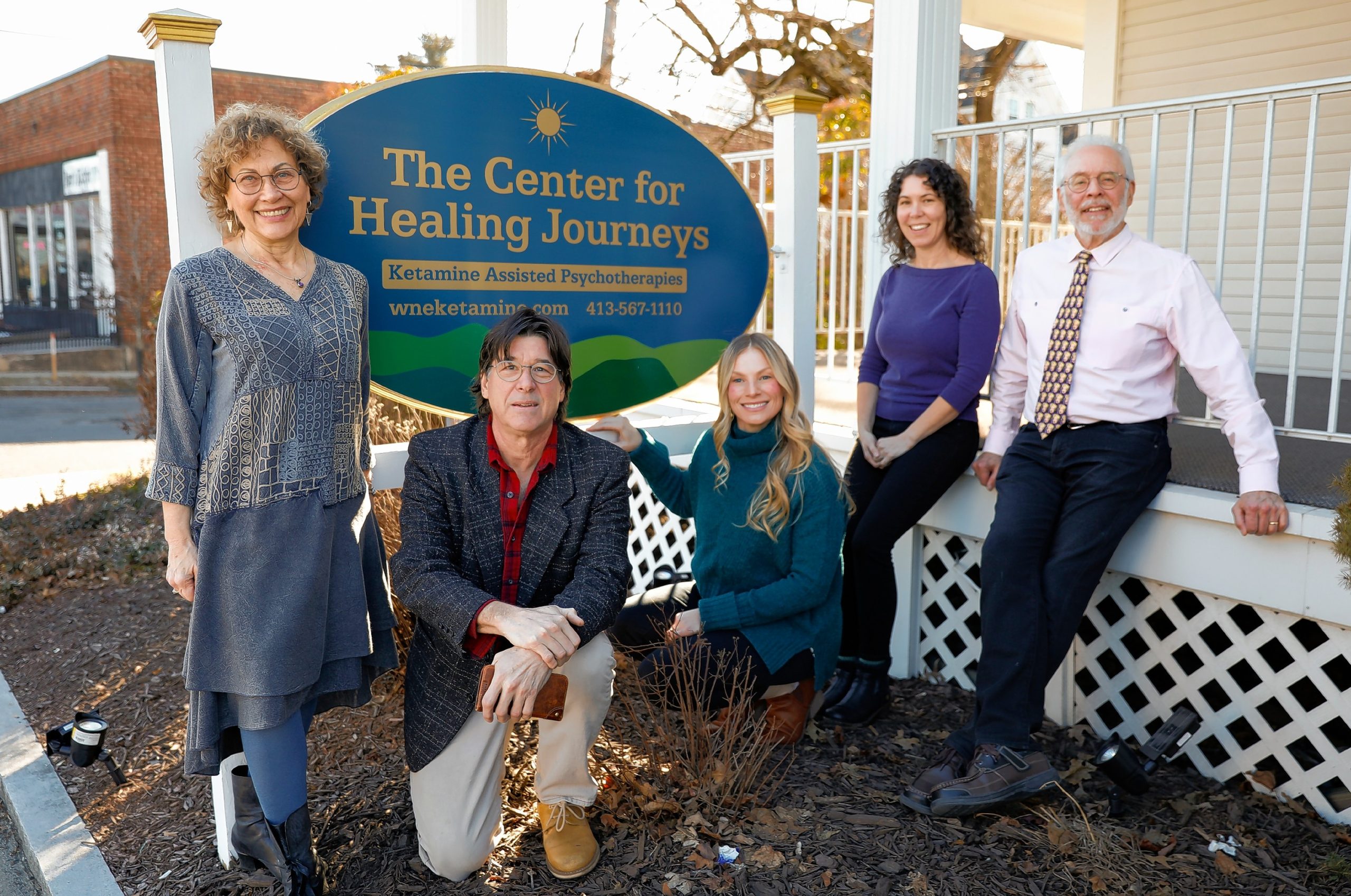
STAFF PHOTO/DAN LITTLE
The team at the Center for Healing Journeys, from left, Lily Gaev, Peter Corbett, Kate Hawk, Natalie Baker and Bennett Gaev.
“Can’t wait,” she said, about bringing her clients to the Center. “No one has ever used ketamine in an intensive setting. Research shows such amazing effects, something that can be so transformative.”
Of the ketamine experience, she said, “I can’t tell you how fortunate I am to not suffer from depression. But I wanted to find the root cause of my anxiety.”
She says it’s not uncommon for people to be apprehensive about taking the drug, “that fear of losing control. I love the feeling of being out of my body, at the same time I’m thinking ‘who’s gonna take care of my kids if I’m out of my brain?’” she laughed.
“My inner narrator went away, eye-opening fantastic colors, intense and vivid, other ones grey and black.”
“The integration piece is so important — how to make meaning of it and how to go forward,” she said of the post-trip part of the session. “I found myself on the brink of emotional pain. Psychotherapy gives you what you need and not what you want. But I was held and nurtured therapeutically the whole way.”
“Ketamine and psychotherapy — there’s nothing to compare it to,” said Rattner.
Her advice for a first-timer? “Remain open and curious; allow the medicine to take you away. Remember, you’re always evolving, striving to be as self-led as possible.”
Awaaay we go
Annemarie drops me at the Center for Healing Journeys on a sunny Friday in ‘Hamp. I am to meet the Gaevs for my psychiatric evaluation.
That’s the other thing — I’ve never had a psychiatric evaluation. I’m sure listeners of my morning radio show diagnosed me going into every break. But lying on a couch talking about my mother? Not that I can recall.
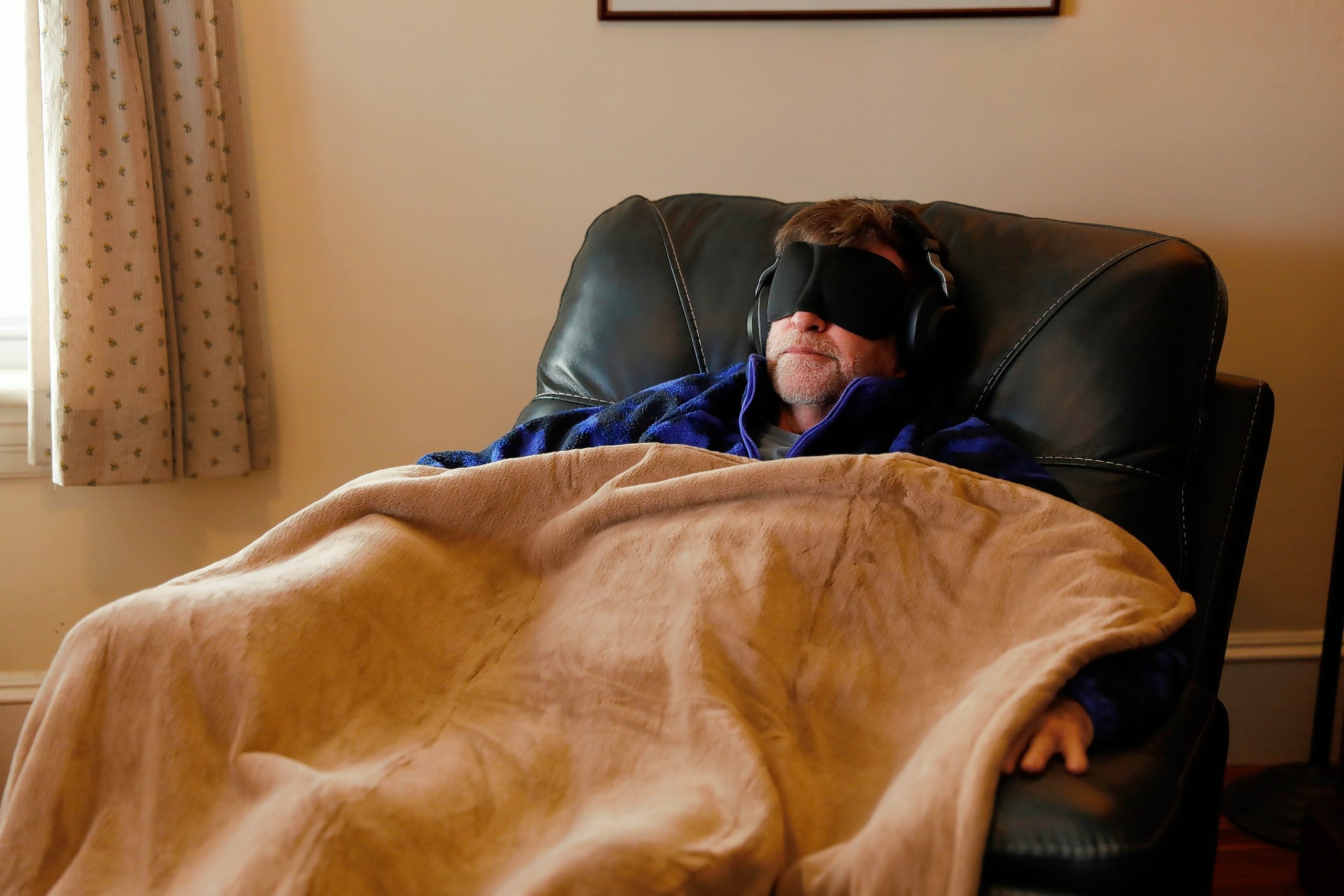
Bob Flaherty demonstrates the setup of going through ketamine assisted psychotherapy at the Center for Healing Journeys in Northampton.
STAFF PHOTO/DAN LITTLE
I’m also not depressed or suicidal. What I am is sad because my dog just died. I’m sad about the world too but the dog made me cry. But I’m not depressed, and I don’t take much in the way of meds, and I’m pretty healthy and everything and still in a love affair with my bride of 45 years and we both consume news minimally.
If I’ve learned anything in the last week it’s to set intention. This therapy is for those who are stuck in a rut, right? Oh the curse of the multi-talented, self-proclaimed genius who flits from one creative project to another like a pollinating bee. I, at long last, would like focus. It’s not the cliché of finishing that novel that’s been in the drawer for decades — I’ve written two since COVID. It’s remembering to send the damn things out. So that’s my intention: focus!
I was asked what my fears were and I said, “Dying with my present day bank account.”
“Have you ever been diagnosed with ADHD?” asked Lilly.
“Not in so many words,” I shrugged.
“It can be treated,” smiled Bennett.
Anyway, so delightful was my evaluation I got to know Bennett and Lilly Gaev as much as they got to know me. When I asked how you maintain a 52-year marriage while working side by side, I knew exactly what the answer would be. “Dates!” cried Lilly. “You never stop having dates!”
They talk of their tandem bicycle dates through Norway, Sardinia, Switzerland. He always has the front seat. “She pedals when she feels like it,” he grins.
“You can’t not pedal!” she cries.
“You can pedal or you can pedal,” he chides. You can see they get a kick out of each other.
Or maybe I’m stalling.
I’m worried about throwing up. Amusement park rides — those tea cups that spin and spin? Barf city, man. I am given a tablet of Zofran to keep the stomach intact.
There are a couple ways to use the ketamine and doses differ. A light dose, says Lilly, gets a patient pretty relaxed and able to talk openly, but not with a whole lot of psychedelia. A medium dose tends to put one in more of a trance-like state, while a higher dose is said to be “transformative and mystical.” Gee, I don’t know. Mystical? Mystical lands me in the middle of Steve Ditko’s cover illustrations for Doctor Strange, and there I be, back in the Dark Dimension battling the dreaded Dormammu to the bloody death. Uh, I’ll take the medium, please. I fall into the recliner but quickly move to the couch and Lilly fits me with a blanket.
I could have downed the joy juice in lozenge form but I’ve decided to get the shot, or shots. They’ll be spread out a bit so I’m not on a slingshot to the moon. “You’re here, I’m here,” Lilly reassures me, and as Bennett goes to get the medicine, she reads me a Kipling poem that begins: “There is sorrow enough in the natural way; For men and women to fill our day; And when we are certain of sorrow in store, why do we always arrange for more? Brothers and sisters, I bid you beware, of giving your heart to a dog to tear.”
If I wasn’t nervous I’d be bawling.
On go the blindfolds, on go the headphones with the gorgeous Native American wood flutes, in goes the prick of a needle, and the medicine is in me. Oh boy.
Pitch dark. But the suggestive kind of dark, like the screen before the movie starts. Could the music be any cooler? Perfect for doing peyote in the desert with the Lizard King. Very enjoyable, nothing to look at, breathing easily … hands and teeth getting numb?
Wait. I make out what looks to be a tree-line. I shoulda brought a flashlight, I may have uttered, not sure, but I’m suddenly moving, really moving, fading in and out of something, a shoreline maybe, a jagged rock, but everything still dark. Now a land mass faintly comes into view, or is it a map? A three dimensional map with raised terrain and names of locations in unrecognizable letters.
What follows is pure intensity.
Surroundings very dark and claustrophobic with a reddish tinge. Not blood red, don’t worry, more like red clay with the texture of elephant hide. I felt Lilly’s hand on my arm a couple times, indicating that I must have been grimacing.
I would not call my experience flying nor floating. It felt more like I was flat on my back on a conveyor belt, with a thousand tiny skate wheels loudly grinding away underneath me. I am going in and going out, as if entering the folds of giant drapes, deeper and deeper with each fold, and the drapes bear notations, a language at once familiar but foreign, then a slip of light and the face of a refrigerator dotted with magnets? Then deeper into the folds, dark, dark, darker, like the ancient wooden living rooms of my childhood.
Through all of this, it must be noted, I was still aware that I was in a sunlit office on King Street — you could see a tiny wink of light at the corner of the blindfold. Reality was still with me.
Until it was not.
There was this moment — a flash of planet blue and a return to the murkiest of reds as my screeching wheels conveyed me into the deepest of all the folds — that I felt I had lost myself. I had lost Bobby. I wasn’t sure if Bobby was ever coming back. I was not stressed in any way over this. But Bobby might be gone.
Soon after, the images faded, reality’s light again appeared at the edge of the blindfold, and I heard Lilly’s voice. The conveyor belt remained, though, pressing into my back and buttocks, electric current pulsing all through my body like the buzz of an old toaster.
All extremities still numb, legs and arms not useful. This is disassociation, my friends, almost as weird as the trip.
I told Bennett and Lilly about the map. Could be significant, we all agreed. I told them about the sense of losing myself and being okay with it.
“A common state,” said Lilly, “and really valuable moving forward.”
They tell me that’s it’s unlikely to find much meaning your first time out, that it may need time to percolate, and that’s good because I have no idea on earth what the hell just happened.
And then I had to throw up, which directly led to my next dilemma: the odd detachment of my arms and legs. Bennett grabbed me and somehow got me to the bathroom and it wasn’t pretty, though my aim was surprisingly true. It would be some time before attempting the stairs. My hosts were patient.
Okay, I am truly a lightweight. I won’t be the last. Fellow lightweights: go with the low dose and work your way up.
So would I do it again? I don’t know — that out of body stuff? See amusement parks above.
The psychotherapy part I enjoyed most. But psychonaut material? Me? We’ll see.
My son Brendan picked me up and drove me home. On the way he told me of his countless youthful adventures with mushrooms. Not a single one of these stories, I observed, were shared with us while we were raising him.

